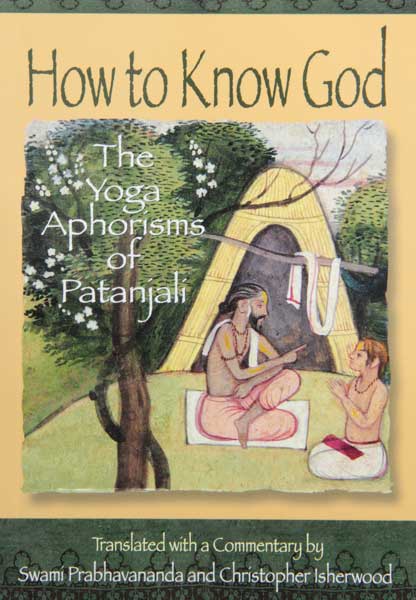Many Eastern scriptures are now provided in English. Patañjali’s Yoga Sūtras is an essential text to the aspiring yogi. The Sūtras describe the path to enlightenment by various traditional practices. The first sūtra states a definition of yoga that is sometimes forgotten: “Yoga is the control of thought-waves in the mind.” The mind plays the most significant role in our spiritual quest. Without this basic understanding, we miss the goal completely.
Authorship of the original Yoga Sūtras is attributed to the wise sage, Patañjali, about whom we know very little. There is some discussion about the date of its writing, but it’s roughly as old as The New Testament.
Many yogic scriptures are written as sūtras, often very short, cryptic phrases. Sūtras contain deep spiritual truths. They sometimes take years of meditation and study to grasp. If you read a direct Sanskrit-English translation of them, you might find it very difficult to understand. Even a Sanskrit scholar would not be able make sense of it. For example, the following verse is one of the Yoga Sūtras’ most important — if taken at face value, it seems simple, but reflection on the verse opens the door to the mysteries of the text:
“The universe exists in order that the experiencer may experience it, and thus become liberated.”
To understand a collection of sūtras like Patañjali’s, you need knowledge of the subject matter itself. That’s why we depend on commentaries. These are written by advanced yogis with deeper knowledge.
How to Know God, The Yoga Aphorisms of Patañjali (aff link) is such a commentary. Swami Prabhavananda and Christopher Isherwood explain the Sūtras for the Western mind. They define Eastern concepts in our terms, and they make references to which we can relate. As Western readers, we are often confused by the various references to deities of the East. The authors address this at the very beginning:
“God, the underlying Reality, is by definition omnipresent. If the Reality exists at all, it must be everywhere; it must be present within every sentient being, every inanimate object. God-within-the-creature is known in the Sanskrit language as the Ātman or Purusha, the real Self.”
Anyone interested in Eastern philosophy will find this text helpful. Patañjali’s yoga is for everyone. The authors often mention Hinduism, but the principles contained here are universal.
The Structure of How to Know God, The Yoga Aphorisms of Patañjali
This book contains four sections:
I: Yoga and Its Aims
II: Yoga and Its Practice
III: Powers
IV: Liberation
As a handbook for anyone on the spiritual path, this book is especially helpful. The authors carefully explain some of the most basic yogic concepts. If you wish to know the meaning and effects of meditation, read this book. If you want to avoid the pitfalls and obstacles along the path, they are clearly shown here. And if you seek a clear, authoritative, definition of OM (or AUM), turn to the commentary on Sūtra 27 in the first section.
The second section, “Yoga and Its Practice,” will be familiar to those who favor Ashtanga Yoga, Patañjali’s Eightfold Path. A pure mind and body are requirements for higher steps along the path. Yamas and niyamas, basic yogic practices, are the necessary virtues and observances for purification. The authors of How to Know God, The Yoga Aphorisms of Patañjali understand their audience—you, the Western seeker. They give sound explanations for these practices.
Students are often confused by yogic concepts like the gunas, the three qualities of nature. Prabhavananda and Isherwood clarify the gunas and their purpose. They explain that the three gunas are always present in our lives. As we learn to identify them, we can use them to our advantage.
How to Make the Most of How to Know God, The Yoga Aphorisms of Patañjali
Study of this book will increase your understanding of yoga as a spiritual path. I use the word study intentionally. The text deserves attention and concentration. It’s easy enough to read its words, but to truly grasp the teachings requires time and effort. You can expect the best results with sincere effort.
As a student of yoga or any other spiritual path, you will return to this book repeatedly. As a newcomer to the text, commit to reading it first cover to cover. Don’t stop to do deeper research or even reflect. Just get the overview before returning to a deeper reading.
Then return to the sections on practices, and get to work. Yoga is a process of baby steps, taken over a long period of time. Take How to Know God, The Yoga Aphorisms of Patañjali along on your journey, and you will discover how it assists you in deepening your practice.
Chityānanda has been a disciple of Svāmī Gurupremānanda Sarasvatī since 1975. She teaches meditation and yoga as a spiritual path in Santa Cruz, California.


Thank you so much for this post. I find it very helpful and intend to read this book abut the Sutras of patanjali. Your encouragement and inclusion are received.
Thank you for your comment, Karyn. This has always been my favorite version of the Yoga Sutras because of its commentaries. I hope you will enjoy them too.